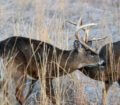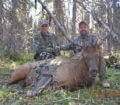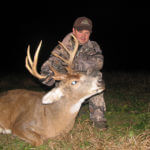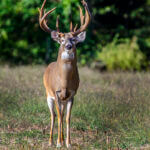Editor’s Note: Bill Custer of Clovis, California, is a member of several outdoor companies’ pro staffs and has hunted elk in Oregon, New Mexico and Utah. But 90 percent of his hunting is in Colorado on public lands where he can buy a tag over the counter. This will be his 35+ season hunting elk on public lands, where he’s taken numbers of elk with his bow.
You won’t really find elk when you’re driving around in your ATV or truck. You have to get down in the canyons where the elk live. Elk on public lands are streetwise. They know that bulls and cows don’t ride in the backs of pickup trucks and call from the road. Today’s elk aren’t like they were 25-years ago. They’re way too street-smart to let you just take a shot at them. I start hunting from the time I leave my camp. I’ve taken elk within 1/2-mile from camp before, and I’ve also taken them 5-miles from camp. There’s a wallow 1/2-mile from my usual camp where I can hear my camp’s generator running from my tree stand at the wallow. Other people have hunted this wallow, but they don’t know when to be there to take an elk. I’ve taken three bulls there. But most often I’m well away from camp or any road when I hunt elk.
 One reason more people don’t take elk on public lands is that elk today aren’t as vocal as they once were. On public lands, you need to be more diligent at hunting elk than calling elk. I’ve won several elk-calling contests, and I love to talk to elk, but I’ve changed tactics. I spend more time hunting water or wallows and using the spot-and-stalk method than I once did. So, get away from the road, shut-up, and hunt.
One reason more people don’t take elk on public lands is that elk today aren’t as vocal as they once were. On public lands, you need to be more diligent at hunting elk than calling elk. I’ve won several elk-calling contests, and I love to talk to elk, but I’ve changed tactics. I spend more time hunting water or wallows and using the spot-and-stalk method than I once did. So, get away from the road, shut-up, and hunt.
Secret #2: Learn to Speak the Elk’s Language:
Elk have a definite language. Most people who hunt public lands think they just have to make elk sounds, and elk will come to them. But if I started speaking Chinese to you, unless you’re from China, you wouldn’t understand a word I was saying. The real secret to talking to elk is to convince them that you’re an elk, not a human. I don’t understand the entire elk language, but I learn a little more every year. For instance, I jumped some cows coming down a trail, and they ran out a little and started barking at me. I call this cow bark a show-me-what-you-are call. I barked back at the cows, and within 15 minutes they were in my lap. So, I’ve been using an elk bark quite a bit lately, and it’s been very effective.
 Anytime I’ve got my boots on during elk season, I have a diaphragm mouth call in my mouth all the time, because I never know when I’ll need it. I don’t take the call out of my mouth until I’m back at camp. I use a wide variety of diaphragm calls, mainly from Primos (http://www.primos.com/) and Bugling Bull (http://buglingbull.com/). My favorite Primos call is the Imperial Plate Double, a double-reed call. One of my secrets for calling elk is that I try to mimic every sound I hear from an elk. If I were repeating every word of a conversation I was having with a friend, that friend would get irritated quickly. I’ve learned that if I start telling the elk the same thing he’s telling me, he’ll get irritated and come see who I am, and why I’m being so rude.
Anytime I’ve got my boots on during elk season, I have a diaphragm mouth call in my mouth all the time, because I never know when I’ll need it. I don’t take the call out of my mouth until I’m back at camp. I use a wide variety of diaphragm calls, mainly from Primos (http://www.primos.com/) and Bugling Bull (http://buglingbull.com/). My favorite Primos call is the Imperial Plate Double, a double-reed call. One of my secrets for calling elk is that I try to mimic every sound I hear from an elk. If I were repeating every word of a conversation I was having with a friend, that friend would get irritated quickly. I’ve learned that if I start telling the elk the same thing he’s telling me, he’ll get irritated and come see who I am, and why I’m being so rude.
To learn much more about elk hunting, get John E. Phillips’ eBooks, print books and audiobooks by going to johninthewild.com/books#elk.
To get John and Denise Phillips’ free cookbook, “Miz Denise’s Outdoor Cooking: More than 35 Recipes for Elk and Mule Deer,” and “How to Make Venison Jerky – the Ultimate Snack Food” (recipes also can be used for elk jerky), as well as other free eBooks, go to https://johninthewild.com/free-books.











